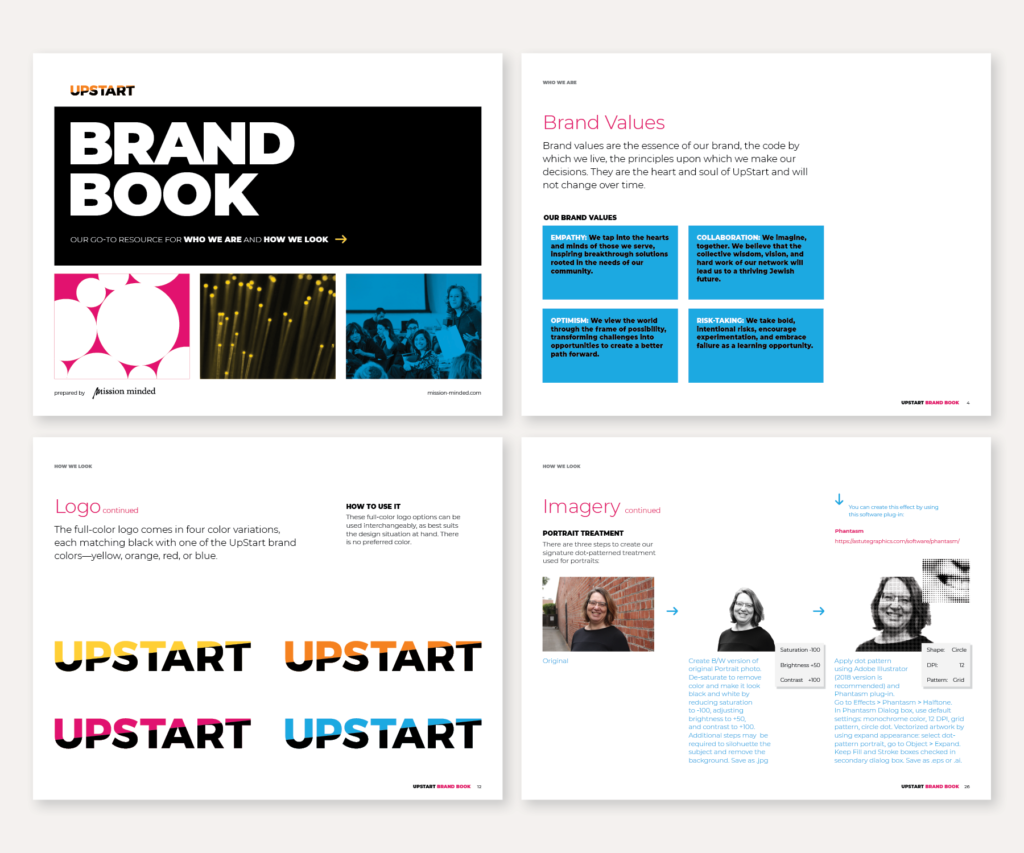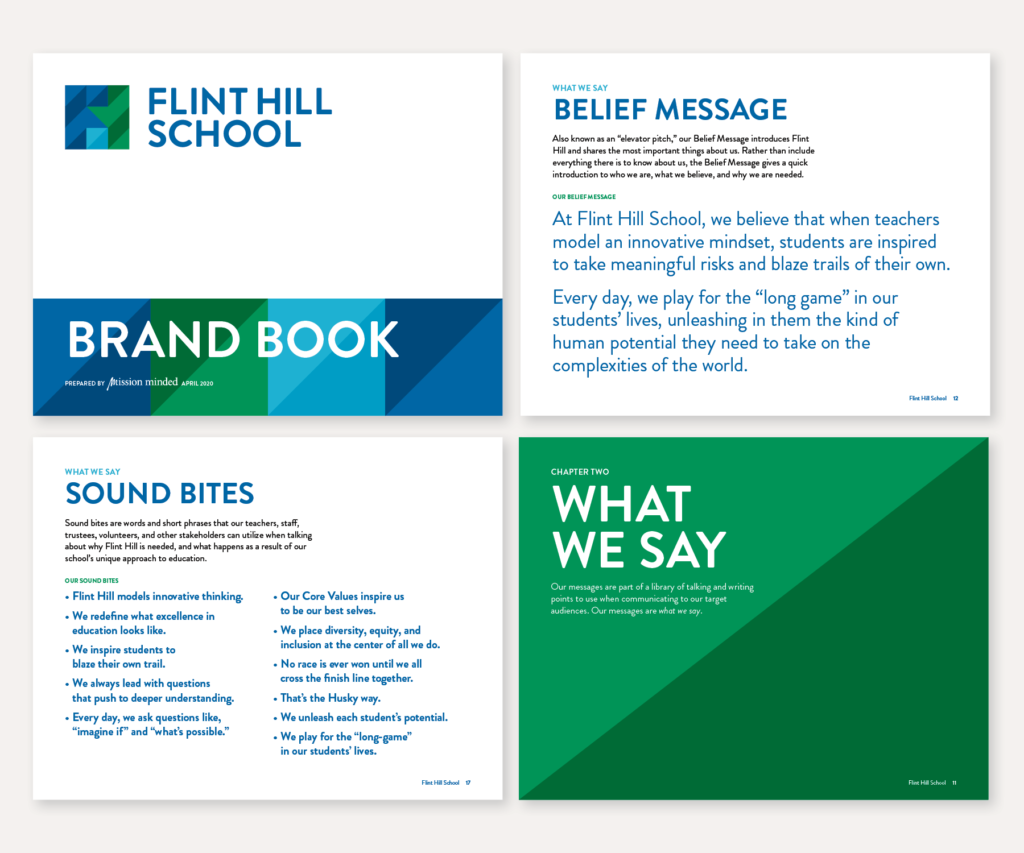Your Brand Book: The Ultimate Guide Every Organization Needs
Posted by Frida Silva on October 5th, 2021
Posted in Blog, Nonprofit Branding, Nonprofit Communications, Nonprofit Design, Nonprofit Messaging, Nonprofit Training

If you walk into a museum, they’ll provide you with a map or guide of what is on display. The map will tell you about the exhibitions, what you will see, who the artists are, and why it all matters.
Your organization should have a similar map or guide that tells everyone, from new incomers to seasoned staff, what your brand is: who you are, how you talk about who you are, and how you look to signal who you are.
In a conversation with Mission Minded Partner & Creative Director Rod Lemaire, I asked him to explain what exactly a brand book is, what role it plays in a nonprofit, foundation or school, and to give examples of brand books that do a good job helping volunteers, staff, and supporters be excellent ambassadors for their organization.
What is a brand book?
A brand book brings together your brand strategy that tells the world who you are, what you say, and how you look. These elements include your key messages, your belief statement, your tagline, soundbites and other visual expressions of your brand such as logos, typography, photo style and color scheme. Other parts of your brand, how you act and what you do, are typically covered in mission and culture conversations rather than in your brand book.
Why is it important?
This is the indispensable guide that tells others how to represent and communicate on behalf of your organization. Your brand book is not a just-in-case-file to be saved on your communications person’s drive. It is meant to be distributed to anyone who communicates for your organization and used routinely, which keeps your brand dynamic and alive. It’s also an essential tool for new members of your staff or board, helping them understand how to represent and live your brand every day.
What are some ways organizations actively use their brand book so it has value rather than getting dusty?
Say you are writing an end-of-year appeal, your brand book should be your first point of reference to begin drafting an on-brand appeal. Your brand book will demonstrate the tone and personality that should come through in your writing.
Whoever is managing your website will consult with the brand book to make sure the font, colors, and images are on-brand and the placement of your logo stays consistent across other mediums and platforms.
Volunteers will check the brand book for your key messages on how they should communicate to the world what your organization is all about.
Anyone who is doing anything on behalf of your organization should receive the brand book at the start of any project. It’s an onboarding tool for your team, for your board, for designers, whether it’s a graphic designer or an architect or even an event designer.
When you use your brand book routinely as your leaping-off point for a project, you ensure that every signal your organization sends is on-brand. This creates a consistency that strengthens your organization and helps people understand and trust what you stand for. People start to recognize you easily and are reminded about what it is that they love about your work.
What are some examples of brand books? Do they all follow the same template?
All brand books contain elements of the organization’s brand and tell internal stakeholders how to use them. And you can also be creative in your approach about how to deliver and present your material in your brand book that ultimately reinforces well, your brand!
For the Children’s Museum of Denver, we were able to design their brand book in a very visual way where we incorporated their colors, fonts, illustrations, and patterns throughout the pages modeling for them how these visual elements bring their brand to life in an experiential way.
In a very different project, UpStart’s brand book had a complex visual design that mirrored the core of who the organization is: creative, innovative, bold, energizing, pragmatic. Their brand book wasn’t just about modeling for the design as we did with the Children’s Museum, it was set-up more as a how-to-guide. For example, they have a system of logos where anyone creating a communication for them could pick the color, which means it changes constantly, thus reflecting that they are always innovative and creative.
Their brand book guides them on how to combine logos with images and graphics. It unpacks all of those visual elements and explains to the reader how to select which photos and for when. It also goes as far as to explain how to create the images themselves with the appropriate filter and graphics from beginning to end so that anyone in Upstart can replicate their branded look.

It really depends on the brand of the organization that determines how those elements will be presented in the brand book. Compared to the previous two examples, some brand books are simple in their delivery and presentation. Don’t confuse your brand book as a compilation of just your logos and color schemes–that is only one part of your brand, your visual identity. Your brand book tells readers what you say to your stakeholders and how. Flint Hill School’s brand book is an example of a simple, straightforward approach. In the first few pages, Flint Hill lays out what their messages are and how to use them as well as appropriate soundbites to use.

Your brand book is your organization’s ultimate visual and verbal communications guide. It has the basic building blocks that are a starting point for any communications effort that gives people the guidance and tools that will help ensure you’re consistently representing your organization and doing all you can to make everyone know what’s at the heart of your work.
Are you wanting to refine your organization’s brand strategy? Mission Minded can help! Let us know how we can support your upcoming branding project.
Frida supports and executes Mission Minded’s Marketing and Client Relationship strategies where she manages social media and digital content, oversees conference speaking opportunities, and acts as project management support on various client engagements.
See all posts by Frida Silva